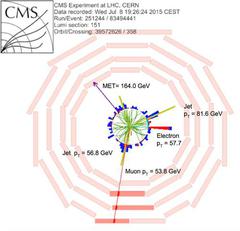Top pair candidate event in the electron muon channel at 13 TeV.
Top Quark Physics
Compact Muon Solenoid Experiment
Top Quark Physics

In the first years of operation, the LHC has proven to be a true top quark factory and top quark measurements are challenging the precision of theoretical calculations. The DESY CMS group is engaged in measurements of top quark pair cross sections (inclusive and differential), in the study of top quark pair events with additional particles in the final state (tt+jets, b-jets, Z and Higgs), in top quark mass measurements and other top quark property measurements, like top quark polarization and spin correlation, as well as in the extraction of QCD parameters from the measurements. An event display of a top quark event candidate, with two leptons in the final state is shown below.
The DESY CMS group performs precision measurements of inclusive and multi-differential top quark pair cross sections.
A summary of the inclusive cross section measurements as a function of the center-of-mass energy is shown in the figure below. 2D differential cross sections provide enhanced sensitivity to the parton distribution functions (PDF), especially at large fractional parton momenta (Bjorken-x). This can be seen in the figure at the bottom of this page.
The top-quark mass (mt) is a crucial parameter of the SM. A precise measurement of this quantity is one of the most important inputs to global electroweak fits that provide constraints on the properties of the Higgs boson, as well as on models for physics beyond the SM. In higher-order QCD calculations, the mass of the top quark depends on the renormalization scheme and its value can differ considerably, e.g. for pole-mass or msbar-mass definitions. Therefore, it is important to understand how to interpret the experimental result in terms of the renormalization conventions. Direct measurements of mt rely on the reconstruction of kinematic observables sensitive to mt. These measurements depend highly on the detailed description of the corresponding signal and top-quark mass mtMC in Monte Carlo (MC) simulations. Alternatively, the top-quark mass can be derived indirectly from the cross section measurement. The group at DESY used the inclusive top-quark pair production cross section measured by CMS in the dilepton channel to extract the top-quark mass through its comparison to three different fully inclusive calculations at higher-order perturbative QCD, which provide an unambiguous definition of mt. The extraction provides an important test of the mass scheme as applied in MC simulations and gives complementary information, with different sensitivity to theoretical and experimental uncertainties than direct measurements of the top-quark mass mtMC, which rely on the kinematic details of the mass reconstruction. The results, both for the pole-mass and the mass definitions, are in very good agreement with similar measurements at the Tevatron and from ATLAS, and provide, for the first time, the determination of the top quark mass at the LHC.
Click on the link to have a look at the publications of the top group